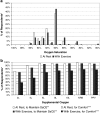Outcomes considered most important by emergency physicians when determining disposition of patients with pulmonary embolism
- PMID: 21373290
- PMCID: PMC3047862
- DOI: 10.1007/s12245-010-0206-8
Outcomes considered most important by emergency physicians when determining disposition of patients with pulmonary embolism
Abstract
Purpose: Clinical decision rules for the disposition of patients with pulmonary embolism (PE) are typically validated against an outcome of 30-day mortality or disease recurrence. There is little justification for this time frame, nor is it clear whether this outcome reflects emergency department (ED) decision making.
Aims: To determine which outcomes emergency physicians (EP) consider most relevant to disposition decisions.
Methods: Survey of attending EPs in geographically diverse US states using acute PE as the diagnostic framework. Responses required single-answer multiple choice, a numerical percentage, rank-ordered responses, or a five-point Likert scale. We distributed the survey via e-mail to 608 EPs.
Results: We received responses from 292 (48%) EPs: 88% board certified, 91% trained in emergency medicine, and 70% work in academics. Respondents reported discharging 1% of patients with PE from the ED, but 21% reported being asked to do so by an admitting service. EPs were more interested in knowing 5-day (in hospital) outcomes [192/265, 72% (95% exact CI = 66%-78%)] than 30-day outcomes [39/261, 15% (95% exact CI = 11%-20%)] or 90-day outcomes [29/263, 11% (95% exact CI = 8%-15%)]. On a Likert scale, 212/241 (88%, 95% exact CI = 83%-92%) agreed or strongly agreed that they considered 5-day (in hospital) clinical deterioration when making a decision to admit or discharge a patient from the ED compared to 184/242 (76%, 95% exact CI = 70%-81%) and 73/242 (30%, 95% exact CI = 24%-36%) for 30 and 90 days, respectively. A wide variety of clinical outcomes beyond death or recurrent PE were considered indicative of clinical deterioration.
Conclusions: Five-day (in hospital) outcomes that incorporate a variety of clinical deterioration events are of interest to EPs when determining the disposition of ED patients with PE. Researchers should consider this when developing and validating clinical decision rules.
Keywords: Clinical decision rule; Emergency department; Outcomes; Pulmonary embolism; Venous thromboembolism.
Figures


References
LinkOut - more resources
Full Text Sources

